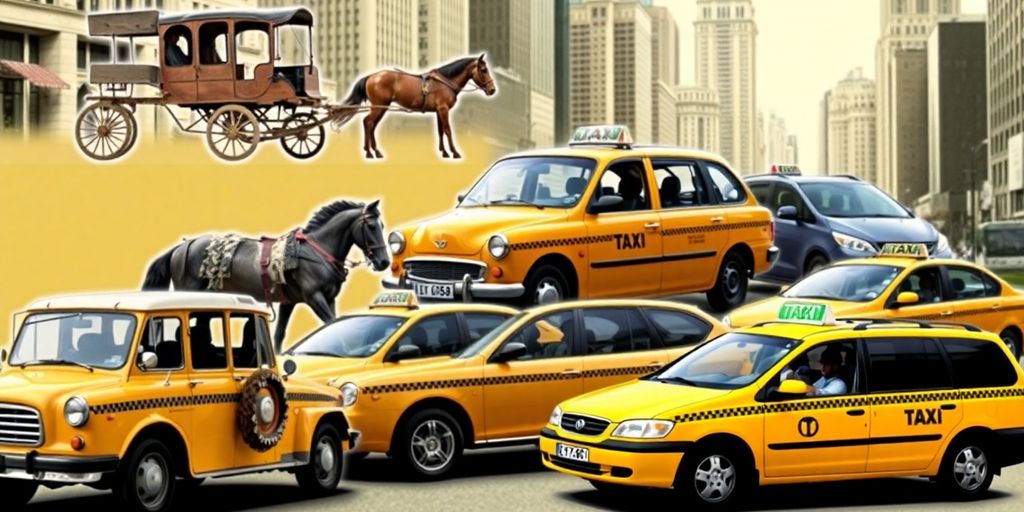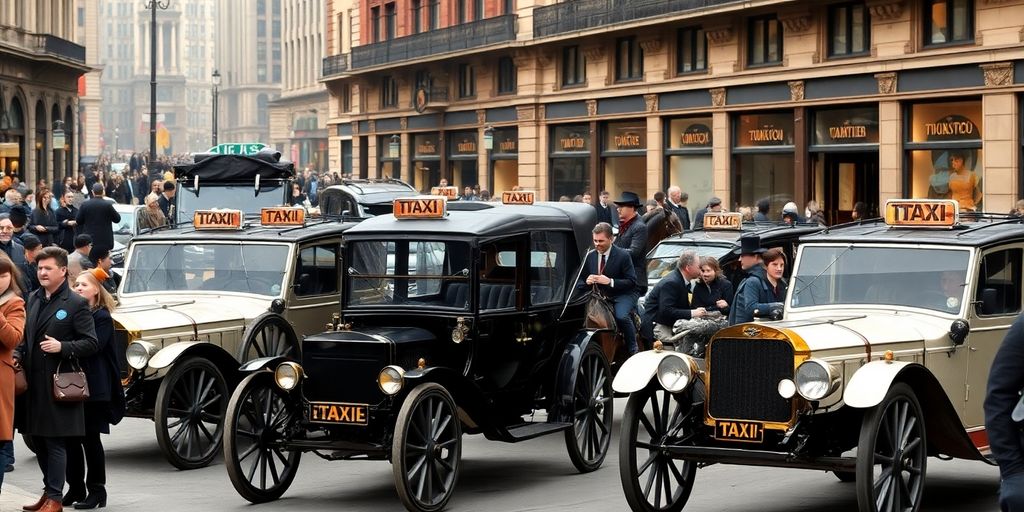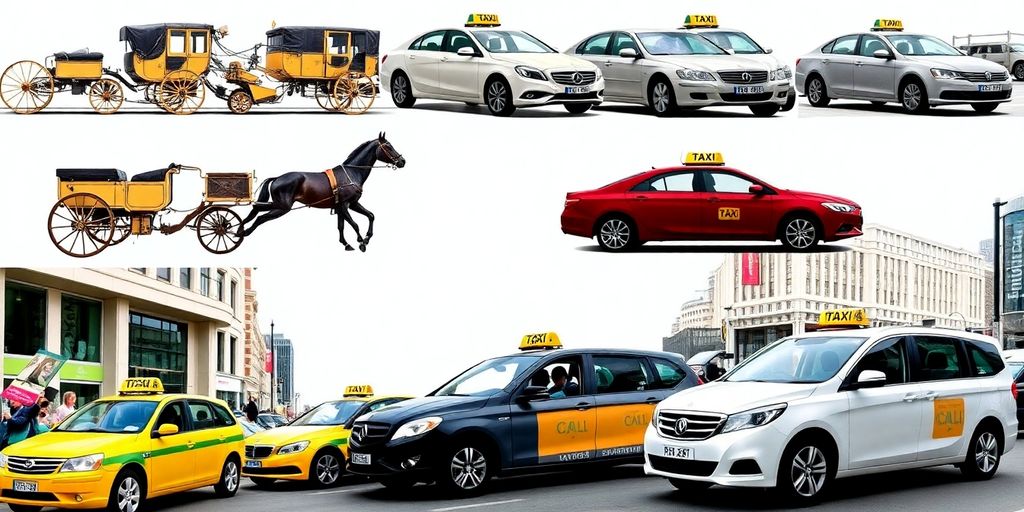Taxis have been around for ages, and their story is pretty wild. From the days when horse-drawn carriages were the go-to, to now when you can just tap a button on your phone for a ride, taxis have really changed the way we get around. This article is all about digging into that journey and seeing how taxis went from old-school carriages to the high-tech ridesharing apps we use today.
Key Takeaways
- Taxis started with horse-drawn carriages in the 17th century.
- The first motorized taxis hit the streets in the early 1900s.
- Taxi meters and radio dispatch systems changed how taxis operate.
- Ride-sharing apps like Uber and Lyft transformed the taxi industry.
- The future of taxis might include driverless cars
Taxis have been a part of urban life for centuries. They are more than just a way to get from point A to point B; they are a reflection of how cities grow and change. The story of taxis is the story of urban development itself.
From their beginnings as horse-drawn carriages to today’s high-tech ridesharing apps, taxis have adapted to meet the needs of the times. They have served as a bridge between the past and the future, connecting people to places when other forms of transportation couldn’t.
Also, if you’re looking for a taxi in Uttoxeter, check this out.

A Brief Overview
- Horse-Drawn Beginnings: In the 17th century, London introduced horse-drawn carriages for hire, setting the stage for the taxi industry.
- Motorized Revolution: The early 20th century saw the transition to motorized taxis, which made urban transport more accessible.
- Modern Innovations: Today, taxis have evolved with technology, incorporating GPS and mobile apps to enhance the passenger experience
The Origins of Taxis
Before cars roamed the streets, carriages were the go-to for getting around town. Picture this: it’s the 17th century in London, and you’re trying to hail a ride. Instead of a yellow cab, you’re flagging down a horse-drawn carriage. These early taxis were a bit of a free-for-all—anyone with a horse and a carriage could offer a lift. It was a time where the rich flaunted their wealth with ornate carriages, while the rest relied on whatever was available. The concept of paying for a ride was born here, setting the stage for today’s taxi fares.
The First Motorised Taxis
Fast forward to the late 19th and early 20th centuries. The world is changing, and so is transportation. The first motorized taxis hit the streets, and it’s a game-changer. These vehicles were more than just a novelty; they were a revolution. No more relying on horses, which meant faster, more reliable rides. The introduction of motorised taxis also brought about the need for some rules and regulations. Cities began to see the potential of this new mode of transport, leading to the establishment of taxi companies and eventually, the standardisation of services. This shift marked the beginning of the modern taxi industry, paving the way for the iconic yellow cabs and beyond.
Taxis in the Early 20th Century

The Rise of Taxi Companies
In the early 20th century, the taxi industry began to take shape with the establishment of organized taxi companies. These companies introduced a level of professionalism and structure that was previously absent. The iconic yellow cab made its debut during this era, becoming a symbol of urban transportation. Albert Rockwell’s Yellow Taxicab Company, for instance, chose the colour yellow because it was deemed the most visible from a distance. This decision not only helped in branding but also in making taxis easily recognisable to potential passengers.
Regulation and Standardisation
As taxi services grew, so did the need for regulation to ensure passenger safety and fair pricing. Cities introduced licensing requirements and fare regulations, which helped establish a standard for taxi operations. This period also saw the introduction of taxi meters, which became a crucial tool for ensuring passengers were charged fairly based on distance traveled. These meters helped in eliminating disputes over fares and provided a transparent pricing model.
The structured growth of taxi services not only improved reliability but also set a precedent for future innovations in the industry. The changes during this period laid the groundwork for the technological advancements that would follow, ensuring that taxis remained a vital part of city life.
The Impact of Technology on Taxis
The Introduction of Taxi Meters
Back in the day, figuring out the cost of a taxi ride was a bit of a guessing game. Then came the taxi meter, a game-changer for both drivers and passengers. The introduction of taxi meters brought transparency and fairness to the fare system. No more haggling over prices or wondering if you got ripped off. These devices calculated fares based on distance and time, ensuring everyone paid their fair share. It was a win-win: drivers got paid accurately, and passengers felt more confident about the cost.
Radio Dispatch Systems
Before smartphones and apps, radio dispatch systems were the cutting-edge tech in the taxi world. These systems allowed taxi companies to communicate with their drivers in real-time, dispatching them to pick up passengers more efficiently. Drivers didn’t have to roam the streets aimlessly, hoping to spot a raised hand. Instead, they could respond to calls from a central office, optimising their routes and reducing wait times for passengers. This innovation not only improved the efficiency of taxi services but also laid the groundwork for the tech-driven dispatch systems we see today.
The Modern Era of Taxis
The Advent of Ride-Sharing Apps
In recent years, the taxi industry has seen a massive shift with the introduction of ride-sharing apps. These platforms, like Uber and Lyft, have changed how people think about getting from point A to B. With just a few taps on a smartphone, a ride can be arranged, often at a lower cost than traditional taxis. This convenience has led many to prefer ride-sharing over conventional taxis. However, this shift hasn’t been without its challenges. Traditional taxi companies have had to adapt quickly, embracing technology to stay competitive. Many have launched their own apps, offering features like GPS tracking and cashless payments.
Ride-sharing apps have also sparked debates around regulation and fairness. Established taxi operators argue that these new services operate in a regulatory grey area, often without the same constraints they face. This has led to calls for more balanced rules that ensure fair competition and protect both drivers and passengers.
The Future of Taxis
Looking ahead, the taxi landscape is poised for further change. Autonomous vehicles are on the horizon, with companies like Tesla and Waymo testing self-driving cars. These vehicles promise to revolutionize urban transport, potentially reducing costs and increasing safety. But they also raise questions about the future of taxi drivers and how cities will adapt to this new technology.
Environmental concerns are also shaping the future of taxis. There’s a growing push towards electric and hybrid vehicles, aiming to reduce emissions and create a more sustainable transport system. Many cities are encouraging taxi companies to adopt greener technologies, aligning with broader efforts to combat climate change.
The modern era of taxis is marked by innovation and adaptation. From the rise of ride-sharing apps to the potential of autonomous vehicles, the industry is constantly evolving to meet the needs of today’s travellers. As cities continue to grow and change, taxis will undoubtedly play a key role in shaping the future of urban mobility.
Wrapping Up the Journey of Taxis
So, there you have it, the wild ride of taxis from horse-drawn carriages to the app-driven rides we know today. It’s been quite the evolution, hasn’t it? Taxis have always been there, adapting to the times, whether it’s the iconic yellow cabs or the sleek electric vehicles of the future. Sure, they’ve faced their fair share of bumps in the road, like competition from ridesharing apps and the push for greener options. But through it all, taxis remain a vital part of city life, getting us where we need to go. As we look ahead, who knows what the next chapter will bring? Maybe driverless cabs or something we haven’t even imagined yet. Whatever happens, one thing’s for sure: taxis will keep rolling on, just like they always have.
